




- BRNN
- BRI News
- BRNN News
- Database
Official Documents Polices and Regulations
Inter-government Documents International Cooperation BRI Countries
Business Guide Economic Data BRI Data
Trade
Investment Projects Latest projects
Cases - Content Pool
Driven by a deep fascination with ceramics since childhood, Sun Tianshu, a post-85s female intangible cultural heritage inheritor from northeast China's Liaoning Province, has revived Liao Dynasty ceramics and helped reshape the future of the ancient craft by breathing new life into it.
Influenced by her mother, who often decorated their home with porcelain, Sun developed an early interest in ceramics. This passion was further nourished during her college years, when she discovered that her university, Shenyang Ligong University (SYLU), offered a ceramics program, and she audited ceramics classes.
After obtaining her bachelor's degree, Sun deepened her passion for ceramics by pursuing postgraduate studies in ceramic art design at SYLU.

Sun Tianshu creates a ceramics piece. (Photo/Yu Haiyang)
In a serendipitous twist of fate, Sun met Guan Baocong, the foremost expert on Liao Dynasty ceramics, which is a traditional craft dating back to the 10th century during the Liao Dynasty (907-1125).
Guan had spent six decades studying Liao Dynasty ceramics and dreamed of resurrecting, innovating and passing down this craft that had disappeared for nearly 300 years.
Impressed by Sun's passion for ceramics, Guan began sharing his knowledge of the history, techniques, and artistic value of Liao Dynasty ceramics with her. Eventually, he expressed a long-held wish, asking if Sun would like to become an inheritor of the craft and carry forward the torch of Liao Dynasty ceramics craftsmanship.
Feeling as if she had been "struck by a bolt of happiness," Sun accepted the challenge without hesitation, embarking on a journey that has been proven both demanding and transformative.
Liao Dynasty ceramics, as a ceramic art form, evolved from the traditional techniques of the Tang Dynasty (618-907) and crafts from central China during the period of the Five Dynasties and Ten Kingdoms (907-979) as well as the Northern Song Dynasty (960-1127). It carries distinct regional cultural characteristics and a nomadic style, according to Sun.
Liao Dynasty ceramics is particularly renowned for its three-colored glazed ceramic ware, with vibrant glazes in yellow, green, and reddish brown.
Sun explained that the ceramic pieces feature flat bodies and intricate decorations, often created with a knife instead of a brush.
At the beginning of her journey of Liao Dynasty ceramics restoration, Sun faced an immense challenge: how to bring this ancient craft back to life with only limited resources and documentation available.
At that time, Guan had already conducted extensive research on the decorative techniques of Liao Dynasty ceramics, but the firing technique was still largely uncharted territory.
Undeterred, Sun adopted a painstakingly slow and methodical approach to unravel the mystery, spending countless hours working with clay and experimenting with various firing temperatures and material compositions.
"I was fearless because I didn't know what I didn't know," Sun explained, reflecting on her early days.
After hundreds of experiments, Sun succeeded in creating ceramic pieces that matched the color, texture, and sound of unearthed Liao Dynasty ceramic artifacts, thus unlocking the "secret" of the traditional craft.
In 2017, when the firing technique for the three-colored glazed ceramic ware of Liao Dynasty ceramics was officially recognized as a municipal-level intangible cultural heritage of Shenyang, Sun was also designated as a representative inheritor of the technique.
Guided by Guan's belief that the goal of reviving Liao Dynasty ceramics is to make it relevant to modern society, Sun has embraced innovation while preserving the authenticity of the ancient craft. She has strived not only to revive it but also carry it forward and develop it for the benefit of the people.
In a cultural and creative industrial park she established in Guchengzi village, Hunnan district, Shenyang, her team has developed over 200 innovative Liao Dynasty ceramic products. These products range from everyday items to high-end art pieces, with some even becoming national gifts for foreign heads of state.
Sun's ceramic creations have also made their way to international stages. In June 2024, her Liao Dynasty ceramic pieces were exhibited at the 2024 Summer Davos at the Dalian International Conference Center in Dalian, Liaoning Province.
In October 2024, her works of Liao Dynasty ceramics were displayed at the Louvre Museum in Paris as part of a Sino-French artistic exchange exhibition.
Despite her growing success, Sun has remained deeply committed to her roots. She has developed easy-to-learn ceramic making techniques and launched training sessions for local villagers in Guchengzi village, offering free classes on the basics of ceramic making.
She provides free materials, tools, and space for residents to learn the craft, and also buys their semi-finished products, creating a sustainable model that helps local youth find employment.
To date, Sun has run more than 50 training sessions, providing job opportunities for over 600 rural youths.
Looking ahead, Sun is focused on two main goals: establishing a benchmark for Liao Dynasty ceramics and promoting Liao Dynasty ceramics-related culture and art education for younger generations.
"Helping more people achieve prosperity is the true measure of entrepreneurial success in my heart," Sun said.

Tel:86-10-65363107, 86-10-65368220, 86-10-65363106